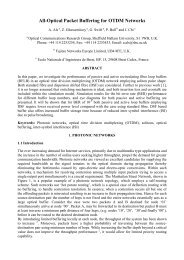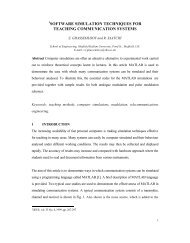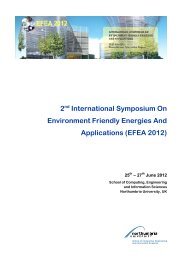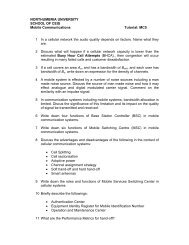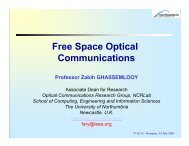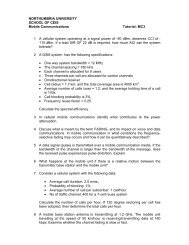Performance of sub-carrier modulated Free-Space Optical ...
Performance of sub-carrier modulated Free-Space Optical ...
Performance of sub-carrier modulated Free-Space Optical ...
You also want an ePaper? Increase the reach of your titles
YUMPU automatically turns print PDFs into web optimized ePapers that Google loves.
<strong>Performance</strong> <strong>of</strong> <strong>sub</strong>-<strong>carrier</strong> <strong>modulated</strong> FSO communication link 345<br />
2 FSO system description<br />
FSO like most communication systems has the following three functional elements.<br />
2.1 The transmitter<br />
This functional element has the primary function <strong>of</strong> converting the source information<br />
into optical radiation which is then propagated through the atmosphere to the receiver.<br />
The essential components <strong>of</strong> the transmitter are: the modulator in this case Phase Shift<br />
Keying (PSK) modulator; the driver circuit for the optical source, which also helps<br />
stabilise the optical radiation against temperature fluctuations and component ageing; the<br />
optical source with direct intensity modulation, where the radiation intensity/irradiance is<br />
proportional to the modulating signal (Gagliardi and Karp, 1995) the transmitter<br />
telescope which collects, collimates and directs the optical radiation towards the receiver<br />
telescope via the atmospheric channel.<br />
2.2 Atmospheric channel<br />
The optical radiation traversing the atmosphere suffers mainly from absorption, scattering<br />
and atmospheric turbulence. These effects are caused by the constituents <strong>of</strong> the<br />
atmosphere (aerosols, gases, smoke, etc.) and the weather effects (fog, haze, temperature<br />
fluctuations, etc.). The atmospheric channel might be the terrestrial distance traversed by<br />
the optical radiation as is the case in this work or the distance between a ground station<br />
and a satellite. The most deleterious <strong>of</strong> all is the thick fog. This can cause attenuation<br />
>200 dB km –1 (Bloom et al., 2003) thereby placing a fundamental limit on the achievable<br />
link range (1 km, the atmospheric<br />
turbulence becomes the prevailing source <strong>of</strong> FSO performance degradation and is the<br />
effect considered in this work.<br />
Solar radiation absorbed by the earth surface causes air around the earth surface to be<br />
warmer than those above them. This sheet <strong>of</strong> warmer air becomes less dense and rises to<br />
mix turbulently with the surrounding cooler air causing the air temperature to fluctuate<br />
randomly (Pratt, 1969). These temperature fluctuations are a function <strong>of</strong> altitude,<br />
atmospheric pressure and wind speed (Zhu and Kahn, 2002). This inhomogeneities<br />
caused by turbulence can be viewed as discrete cells <strong>of</strong> different temperature acting like<br />
refractive prisms <strong>of</strong> different indices <strong>of</strong> refraction. Then, they refract/scatter (depending<br />
on the relative size <strong>of</strong> the optical radiation) an optical radiation traversing the medium<br />
resulting in random irradiance and phase variations. Detailed study <strong>of</strong> atmospheric<br />
turbulence can be found in (Pratt, 1969; Goodman, 1985; Andrews, Phillips and Hopen,<br />
2001; Osche, 2002; Zhu and Kahn, 2002). In this work, the negative exponential model is<br />
considered with irradiation Probability Density Function (PDF) given by (1).<br />
2.2.1 Negative exponential model<br />
In the limit <strong>of</strong> strong irradiance fluctuations, (i.e. in the saturation regime and beyond)<br />
where link length spans several kilometres, the number <strong>of</strong> independent scatterings<br />
becomes large (Karp et al., 1988). The amplitude fluctuation <strong>of</strong> the field traversing the




